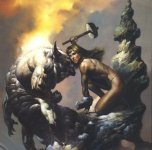 |
A
CELTIC MYTH: PEDRUM
Celtic mythology
describes Pedrum as an evil spirit of the mountains who
lived in the heart of rocks. He would emerge on rainy
days and capture unsuspecting travelers, sucking them
into the rock and crushing their bones. The souls of the
victims added to his strength. Pedrum was eventually
defeated by a gorgeous woman warrior named Maline, who
was armed with an enchanted hammer. At the moment of his
death, the surrounding rocks changed back into the people
he had slain. |
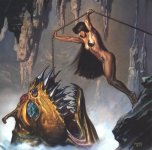 |
A
SLAVIC MYTH: LORIA
Loria, a powerful
enchantress in Slavic mythology, knew of a secret cave
where a magical jeweled fish named Alionu lived. When she
visited Alionu, Loria would bring offerings to feed him.
In return, he would grant her wisdom and magic. |
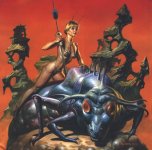 |
A
CARPATHIAN MYTH: NIKATJEF
In Carpathian
mythology, a tribe of insects known as the Lakin was
responsible for order and organization in the world while
a band of menacing goblins known as the Hestas were
constanly working to create disorder and destructiveness.
The evil Hestas would prey upon the eggs of the Lakin in
an effort to eliminate them because once the eggs
hatched, the insects were to powerful a match for the
Hestas. A sprite-like creature called Nikatjef was named
guardian of the eggs in this battle for balance and
harmony. |
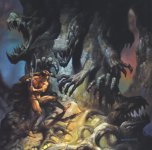 |
A
LATVIAN MYTH: CESIS
Gelvasta, the ruler of
darkness in Latvian mythology, planted seeds in the
center of the earth during the time before the sun came
into being. The seeds grew into an enormous, demonic tree
with branches so thick and tall that it threatened to
cast the world into darkness once again. The sun brought
the champion CÍsis out of the sea to destroy the tree
and restore the sunlight. His enormous power came from
his ankle-length hair and magic silver ax. It took CÍsis
five centuries to complete the task. |
 |
A
GERMANIC MYTH: CELIS
In Germanic mythology,
Celis, daughter of the sorceress Uslani, was the most
beautiful maiden in the kingdom. When a band of savage
flying warriors attempted to steal her as a bride for
their wicked king, Uslani hid Celis in the woods and
changed her into a deer. |
 |
A
ICELANDIC MYTH: KAMAL
In Icelandic
mythology, an enormous spider named Cariden possessed an
enchanted golden sword that would grant its owner any
wish that was spoken out loud. Cariden would hang the
sword in her web to lure winged fairies inside where they
would be trapped and devoured. The brave and bewitching
fairy Kamal tricked Cariden by entrancing her with
fascinating stories. When she was close to the sword,
Kamal touched it and became hers. She then killed Cariden
and became queen of the fairies. |
 |
A
GERMANIC MYTH: FREYA
One of the wives of
Odin, the lovely Valkyrie Freya was the German goddess of
love. With her great strength, each day she pulled away
the darkness that covered the sun and made way for the
brilliance of daylight. Her magic golden necklace, a gift
that Odin had forged for her in the sun, helped Freya
subdue the darkness. |
 |
A
PATAGONIAN MYTH: YHTAC
In Patagonian
mythology, Yhtac was a mermaid who was considered to be
the most beautiful and elusive of all creatures. Her tail
was made of gold and her skin was of pearl. A powerful
sorcerer, Arasmin, created two flying beasts to carry his
castle around the world until they could find her. The
beasts were created with only one wing apiece so they
could not fly alone. Once Arasmin found Yhtac, he
presented each of the beasts with a second wing and set
them free. Arasmin then transformed himself into a sea
creature so that he could join the lovely Yhtac. |
 |
A
PHOENICIAN MYTH: ASHTAROTH
The goddess of the
moon in Phoenician mythology, Ashtaroth is represented as
a beautiful maiden reclining on a cresent moon. Her cult
was strongly connected to those of both Venus and
Aphrodite, and like them, she represented sensuality. |
 |
A
SYRIAN MYTH: ASTARTE
Astarte, the goddess
of war, was also known as mistress of horses and chariots
in Syrian and Phoenician mythology. She captured her
steed, Baldium, from a herd of carnivorous underworld
horses. Baldium would devour the souls of the slain
warriors, wich would serve to make him ever stronger and
more fearsome. |
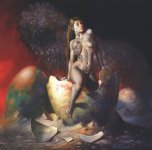 |
A
SIBERIAN MYTH: SUZLE
The Suzle, voluptuous
creatures of Siberian mythology, were hatched from eggs,
and gave beauty and sensuality to the people of the
earth. The Nydan, worm-like creatures with poisonous
spikes, were envious of the Suzle and wanted to destroy
them by making their warm hearts cold. The Nydan were
eventually defeated when the envy of one of the worms
turned to love, and in order to save the Suzle, it
destroyed itself and all of the other Nydan. |
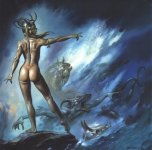 |
A
JEWISH MYTH: LILITH
A female demon of
Jewish folklore, Lilith was Adam's first wife. When Adam
attemped to dominate her, she cursed him and flew away.
Lilith then spent her time coupling with demons of the
air and sea, often generating great typhoons from the
excitement. |
 The Artists
The Artists 
 The Artists
The Artists 
